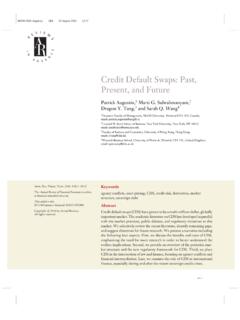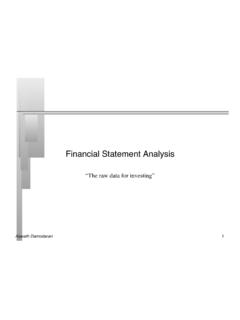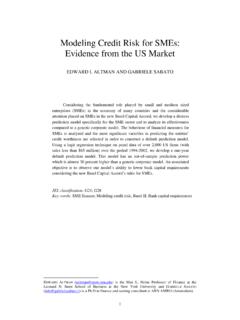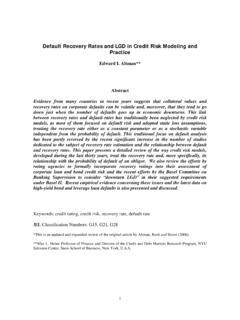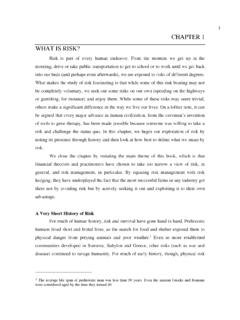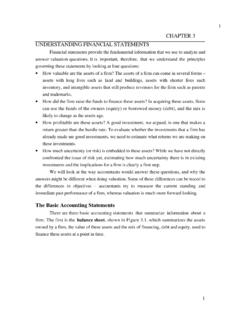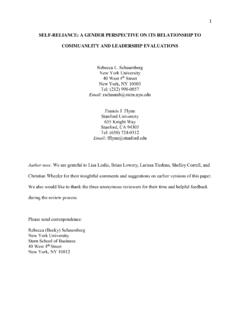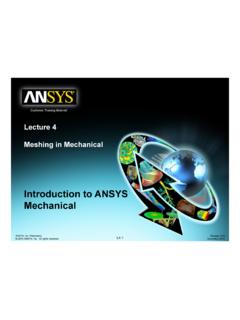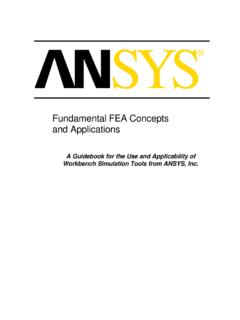Transcription of Introduction to Options - New York University
1 1 Introduction to OptionsBy: Peter Findley and Sreesha VamanInvestment Analysis GroupWhat Is An Option? One contract is the right to buy or sell 100 shares The price of the option depends on the price of the underlying, plus a risk premium It is an option, it is not a binding contract Call Option: Right to buy a share Put Option: Right to sell a share Options traded the same as stocks2 What Makes Up An Option? The strike price is the price at which you can buy or sell shares Expiration date is the last day you can exercise an option Automatically executed on this day Underlying asset is the stock on which the option is written Price of the option is how much investor pays for the right to buy or sell ( premium) Options can be either American or European American-style Options can be executed on any day European-style Options can be executed only on the expiration dateWhat Is Contained In An Option?
2 Right to buy 100 shares Holder of option can buy shares at the strike price Thus, seller of option MUST sell shares at strike price if exercised Calls are in-the-moneyif the strike price is below the stock price Calls are out-of-the-moneyif the strike price is greater than the stock price Calls are at-the-money if the strike price is equal to the stock price Right to sell 100 shares Holder of option can sell shares at strike price Thus, seller of option MUST buy shares at strike price if exercised Portfolio protection Puts are in-the-moneyif the strike price is greater than the stock price Puts are out-of-the-moneyif the strike price is less than the stock price Puts are at-the-money if the strike price is equal to the stock priceCALLPUT3 How Do I Find The Price Of An Option?Three components of the price of an option: Intrinsic Value: value of the option if exercised now Volatility: premium for protection against price fluctuations in the underlying stock Time Value: value of buying option instead of stock Money saved on initial outlay can earn interestWhat Are The Payoffs For A Call?
3 Payoff on OptionPrice of StockCPayoff on OptionPrice of StockCLONG CALLSHORT CALLKK Initially, buyer pays out price of Call (C) Value of long Call increases as value of Stock increases Initially, writer receives price of Call (C) Value of short Call decreases as value of Stock increases4 What Are The Payoffs For A Put?Payoff on OptionPrice of StockPPayoff on OptionPrice of StockPLONG PUTSHORT PUTKK Initially, buyer pays out price of Put (P) Value of long Put decreases as value of Stock increases Initially, writer receives price of Put (P) Value of short Put increases as value of Stock increasesHow Do I Use Options ? Portfolio Insurance Speculation/Leverage Hedging (Which is actually a type of insurance!) Risk Control Targeted returns5 Buy Call at K 1 Write Call at K 2 Lower Cost of Portfolio, but that limits upside Best if you think stock will rest between K 1 and K 2 at maturityWhat Are Some Basic Calls Strategies?
4 Payoff on OptionsPrice of StockPayoff on OptionsPrice of StockK 1K 2 Write Call at K 1 Buy Call at K 2 Take advantage of bearish sentiment by selling a call Hedge your bearish opinion by limiting downsideK 1K 2 Bullish Call SpreadBearish Call SpreadYOU Draw the Diagram: Put SpreadsBullish Put Spread is the same as Bullish Call Spread, using PutsPayoff on OptionsPrice of StockK 1K 2 Payoff on OptionsPrice of StockBearish Put Spread is the same as Bearish Call Spread, using PutsK 1K 26 YOU Draw the Diagram: Put SpreadsBuy Put at K 1, Sell Put at K 2. Use to maximize put portfolio during bull marketPayoff on OptionsPrice of StockK 1K 2 Payoff on OptionsPrice of StockK 1K 2 Sell Put at K 1, Buy Put at K 2. Use to maximize put portfolio during bear marketWhat Is A Straddle?Payoff on OptionsPrice of StockK StraddleIf you think that the underlying asset is volatile, but you don t know which direction, you can hedge yourself by buying both a Put and a Call at strike K.
5 You will make more money as the stock price moves away from is the same as a straddle, but with two different strike prices. This way, you can offset your costs by buying a cheaper call option or a cheaper put option, depending on how far apart you want the Options to 1K 27 How Else Can I Use A Straddle?Payoff on OptionsStockStripsIf you think that the price of the underlying is going to increase, you can buy two calls and, for protection, buy one put. This takes the view that the stock price will go up, but protects you if the stock price goes StrapsIf you think that the price of the underlying is going to decrease, you can buy two puts and, for protection, buy one call. This takes the view that the stock price will go down, but protects you if the stock price goes A Butterfly Spread is the most widely used Options combination. With calls : Long Call at K1 Short 2 Calls at K2 Long Call at K3 Investors make money on the premiums of the two calls sold, plus a potential payoff on the underlying stock price from the long Is A Butterfly?
6 Payoff on OptionsStockFor puts, the butterfly spread is : Long Put at K1 Short 2 Puts at K2 Long Put at K3K 1K 2K 38 YOU Decide: Why Are Options Useful?Risks of an option Unlimited downside risk when shorting (writing) Options If they expire worthless, you lose 100% of your invested capital9 Any Questions?
